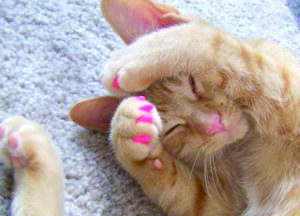By Dr. Beth Leermakers
Why do cats scratch the furniture, and how can you prevent this destructive behavior? Spoiler alert: de-clawing your cat is NOT the right answer.

Photo courtesy of WhattheCat
Why Cats Scratch
Scratching is a normal behavior for cats, who do it to stretch their muscles and maintain/sharpen their claws (in preparation for hunting). Scratching serves several purposes:
• Paw health. The scratching motion of their feet keeps their paws healthy and strong.
• Nail health. A cat’s scratching action removes the dead outer layer of their nails. Think of it as a feline pedicure.
• Scent marking. Your cat’s paw pads deposit their scent as they scratch, marking their territory.
• Self-soothing. Scratching is a way for cats to soothe themselves and show contentment (e.g., by “making biscuits”).
• Entertainment. A bored cat may scratch and shred objects to pass the time.
Because scratching is essential for cats’ physical and mental well-being, you should redirect the behavior to appropriate objects — not stop it.
De-clawing is a Cruel, Painful Surgery
Declawing means amputating part of the cat’s toes (like having the last bone of each of your toes amputated). The painful procedure is illegal in Austin, and many rescue organizations forbid it. According to Austin veterinarian Katrina Breitreiter, who was at the forefront of passing the ban in her city, declawing “can lead to long term complications including persistent postoperative pain, back pain, phantom pain, limping, infection, arthritis, overgrooming, toe pad calluses, bone fragments, claw regrowth under the skin and tendon contracture.” One in five cats has long-term complications from declaw surgery, 50 percent suffer complications immediately after surgery, and one third of declawed cats develop behavioral problems after declawing. Furthermore, the cruel surgery makes it impossible for outdoor cats (or indoor cats that accidentally escape) to climb trees and defend themselves against predators.
How to Redirect Your Cat’s Scratching Behavior and Protect Your Furniture
Discourage your cat from scratching the furniture. If your cat is scratching the sofa, make it less desirable by putting foil over the area he’s scratching. Some veterinarians do NOT recommend using deterrent sprays (canned air or a spray bottle) to punish a cat. Your cat may learn not to scratch when you’re around but resume the behavior when you’re away. The better approach is to teach your cat where you want her to scratch.
Keep your cat’s nails trimmed. Overgrown nails curl and don’t retract completely (meaning any contact with your furniture may scratch it). Severely overgrown and curved nails can grow into the footpad, causing significant pain and mobility problems. Keeping your cat’s nails short is essential. You can trim his nails yourself (good luck with that!) or leave it to your groomer or veterinarian. Cats’ nails should be trimmed every 10-14 days.
Use claw caps. Covering your cat’s claws with plastic caps (such as Soft Paws) protects your furniture without hurting your cat. You or your veterinarian will have to put them on and then replace them every 4-6 weeks, trimming the nails underneath. Some cats remove them, but many cats tolerate them.
Use cat scratchers. Choosing the right scratcher is trickier than it sounds. There are many options — such as wall or hanging cat scratchers, scratch pads or posts — to satisfy even the most particular cats. You may need to provide different types of scratching posts and pads to discover the one(s) your cat likes best.
Identify your cat’s scratching style. Before you run out and buy a scratching post, examine your furniture and carpet to determine whether your cat’s style is
• Horizontal. If your cat scratches the carpet, a horizontal scratching surface like a cat scratch pad or box mimics the floor.
• Vertical. If your cat prefers to scratch the sides of furniture, a wall/hanging scratcher or post is the better option.
Choose the right material. Try different scratchers to figure out what type of material your kitty prefers. Sisal is a popular choice, but your cat may favor recycled cardboard or carpeting.
Encourage your cat to use the new scratcher. Use catnip to attract her to the scratching pad or post. If she ignores it, show her how to use it. Take her to the cat scratcher and gently move her feet over the “good” objects. Praise her and give her treats to reward her for using the scratcher.
Provide exercise and mental stimulation to prevent boredom. Play with your cat, use food-dispensing toys and consider taking her for walks. A happy, tired cat may be less likely to scratch the couch just to have something to do. If your cat is lonely and bored, she may be happier with a feline friend. You may want to adopt a kitten or adult cat. Be patient and introduce them slowly to reduce everyone’s stress.
